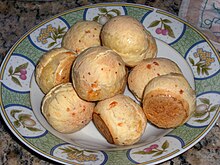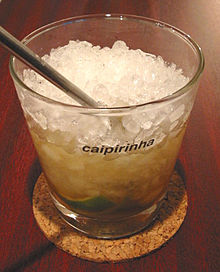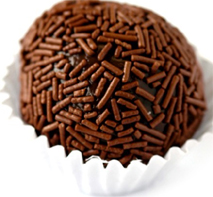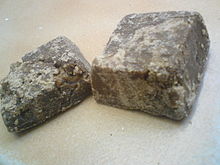Brazilian cuisine: Difference between revisions
Morning277 (talk | contribs) m Reverted edits by 24.190.128.82 (talk) to last revision by 96.51.85.71 (HG) |
|||
| Line 63: | Line 63: | ||
===Typical Cakes (''Bolos'')=== |
===Typical Cakes (''Bolos'')=== |
||
[[File:Bolo de rolo pernambuco brasil.jpeg|thumb|220px|[[Bolo de rolo]], a symbol of [[Pernambuco]].]] |
[[File:Bolo de rolo pernambuco brasil.jpeg|thumb|220px|[[Bolo de rolo]], a symbol of [[Pernambuco]].]] |
||
* ''Pão de mel'' ([[honey]] [[cake]], usually covered with melted chocolate) |
* ''Pão de mel'' ([[honey]] [[cake]], somewhat resembling [[gingerbread]], usually covered with melted chocolate) |
||
* ''[[Bolo de rolo]]'' ([[roll]] [[cake]], a thin mass wrapped with melted [[guava]], most often called ''rocambole'' in Southern and Southeastern Brazil) |
* ''[[Bolo de rolo]]'' ([[roll]] [[cake]], a thin mass wrapped with melted [[guava]], most often called ''rocambole'' in Southern and Southeastern Brazil) |
||
* ''Bolo de cenoura'' (carrot cake with chocolate cover made with butter and cocoa) |
* ''Bolo de cenoura'' (carrot cake with chocolate cover made with butter and cocoa) |
||
Revision as of 23:24, 7 May 2012
| Part of a series on the |
| Culture of Brazil |
|---|
 |
| Society |
| Topics |
| Symbols |


Brazilian cuisine, like Brazil itself, varies greatly by region. The natural crops available in each region add to their singularity.
Brazilian cooking, while it has many similarities with that of its South American neighbors, is distinct. Stretching from the Amazon in the north, through the fertile plantations of the central coast and on to the southern pampas, the food of Brazil spans a unique mix of cultures and cuisines. The original population contributed popular ingredients like [cassava] and guaraná. African slaves influenced the cuisine of the coastal states, especially Bahia. And around the country, a Portuguese heritage is reflected in a variety of dishes.
Root vegetables such as cassava (locally known as mandioca, aipim, or macaxeira), yams, and peanuts,[citation needed] and fruit like açaí, cupuaçu, mango, papaya, guava, orange, passionfruit, pineapple, and hog plum are among the local ingredients used in cooking. Brazilian pine nuts (pinhão) grow in a tree (Araucaria angustifolia) that is abundant in the southern part of Brazil, and are a popular national snack, as well as a lucrative export. Rice and beans are an extremely common dish, as are fish, beef and pork.
Some typical dishes are caruru, which consists of okra, onion, dried shrimp, and toasted nuts (peanuts and/or cashews), cooked with palm oil until a spread-like consistency is reached; feijoada, a simmered bean-and-meat dish; tutu de feijão, a paste of beans and cassava flour; moqueca capixaba, consisting of slow-cooked fish, tomato, onion and garlic, topped with cilantro; and chouriço, a mildly spicy sausage. Salgadinhos, cheese buns, pastéis and coxinha are common finger food items, while cuscuz branco, milled tapioca, is a popular dessert. Brazil is also known for cachaça, a popular native liquor used in the caipirinha.
The European immigrants (primarily from Germany, Italy, Poland, Spain and Portugal) were accustomed to a wheat-based diet, and introduced wine, leaf vegetables, and dairy products into Brazilian cuisine. When potatoes were not available they discovered how to use the native sweet manioc as a replacement.[1] Lasagna, gnocchi, yakisoba, and other pasta dishes are also very popular.
Southeast
The Southeast mostly includes the states of Espírito Santo and Minas Gerais.
In Minas Gerais, the regional dishes include corn, pork, beans, chicken (including the very typical dish frango com quiabo, or "chicken with okra") and local soft ripened traditional cheeses. In Rio, São Paulo and Minas Gerais, feijoada (a black bean and meat stew rooted), is popular especially as a Wednesday or Saturday lunch. Also consumed frequently is picadinho (literally, minced meat), and/or rice and beans.
In Espírito Santo, there is significant Italian and German influence in local dishes, both savory and sweet.[citation needed] The state dish, though, is of Amerindian origin,[citation needed] called moqueca capixaba (a tomato and fish stew prepared in a clay pot). The cuisine of Minas Gerais is also strongly influential there, with many restaurants serving that fare.
North
The cuisine of this region, which includes the states of Acre, Amazonas, Amapá, Pará, Rondônia, Roraima, and Tocantins, is heavily influenced by indigenous cuisine. In the state of Pará, there are several typical dishes including:
Pato no tucupi (Duck in tucupi) – one of the most famous dishes from Pará. It is associated to the Círio de Nazaré, a great local Christian celebration. The dish is made with tucupi (yellow broth extracted from cassava, after the fermentation process of the broth remained after the starch had been taken off, from the raw ground manioc root, pressed by a cloth, with some water. If adding maniva, the manioc ground up external part, that is poison because of the cianic acid, must be cooked for one week long.). The duck, after cooking, is cut into pieces and boiled in tucupi, where is the sauce for some time. The jambu is boiled in water with salt, drained and put on the duck. It is served with white rice and manioc flower.
Other dishes




- Rice and beans is an extremely popular dish, considered basic at table; a tradition Brazil shares with several Caribbean nations. Brazilian rice and beans usually are cooked utilizing either lard or the nowadays more common edible vegetable fats and oils, in a variation of the Mediterranean fried called locally refogado which usually includes garlic in both recipes (many Brazilians do not like garlic on rice, and not using garlic is the standard in restaurants) and sometimes onion, or even welsh onions, parsley, fresh coriander and/or other herbs (again, it depends on personal tastes).
- In variation to rice and beans, Brazilians usually eat pasta (including yakisoba, lamen, and bifum), pasta salad, various dishes using either potato or manioc, and polenta as substitutions for rice, as well salads, dumplings or soups of green peas, chickpeas, black-eyed peas, broad beans, butter beans, soybeans, lentils, moyashi (which came to Brazil due to the Japanese tradition of eating its sprouts), azuki, and other legumes in substitution for the common beans cultivated in South America since Pre-Columbian times. It is more common to eat substitutions for daily rice and beans in festivities such as Christmas and New Year's Eve (the tradition is lentils), as follow-up of churrasco (mainly potato/carrot salads, called maionese, due to the widespread use of both industrial and home-made mayonnaise, which can includes egg white, raw onion, green peas, sweetcorn or even chayote squashes, and pronounced almost exactly as in English and French) and in other special occasions.
- Either way the basis of Brazilian daily cuisine is the starch (most often a cereal), legume, protein and vegetable combination. There is also a differentiation between vegetables of the verduras group, or greens, and the legumes group (no relation to the botanic concept), or non-green vegetables. There are Brazilians which eat both daily or the most often they can, only vegetables of one group, or none at all, which again depends on personal tastes. The comparison between the healthiness of Brazilian and Western foods and tastes is, ironically, debatable.
- Salgadinhos are small savoury snacks (literally salty snacks). Similar to Spanish tapas, these are mostly sold in corner shops and a staple at working class and lower middle-class familiar celebrations. There are many types of pastries:
- Pão de queijo (cheese bun, literally "cheese bread"), a typical Brazilian snack, is a small, soft roll made of manioc flour, eggs, milk, and minas cheese. It can be bought ready-made at a corner store or frozen and ready to bake in a supermarket and is gluten-free.
- Coxinha is a chicken croquette shaped like a chicken thigh.
- Kibe/Quibe: extremely popular, it corresponds to the Lebanese dish kibbeh and was brought to mainstream Brazilian culture by Syrian and Lebanese immigrants. It can be served baked, fried, or raw.
- Esfiha (Arabic: sfiha): another Middle Eastern dish, despite being a more recent addition to Brazilian cuisine they are nowadays easily found everywhere, specially in Northeastern, Southern and Southeastern regions. They are pie/cakes with fillings like beef, mutton, cheese curd, or seasoned vegetables.
- Pastéis are pastries with a wide variety of fillings. Similar to Spanish fried empanadillas, but of Japanese origin (and brought to Brazil by the Japanese diaspora). Different shapes are used to tell apart the different flavours, the two most common shapes being half-moon (cheese) and square (meat). Size, flavour, and shape may vary greatly.
- Empada are snacks that resemble pot pies in a small scale. Filled with a mix of palm hearts, peas, flour and chicken or shrimp.
- Cuscuz branco is a dessert consisting of milled tapioca cooked with coconut milk and sugar and is the couscous equivalent of rice pudding.
- Açaí, cupuaçu, starfruit, and many other tropical fruits are shipped from the Amazon all over the country and consumed in smoothies or as fresh fruit.
- Cheese: the dairy-producing state of Minas Gerais is known for such cheeses as Queijo Minas, a soft, mild-flavored fresh white cheese usually sold packaged in water; requeijão, a mildly salty, silky-textured, spreadable cheese sold in glass jars and eaten on bread, and Catupiry, a soft processed cheese sold in a distinctive round wooden box.
- Pinhão is the pine nut of the Araucaria angustifolia, a common tree in the highlands of southern Brazil. The nuts are boiled and eaten as a snack in the winter months. It is typically eaten during the festas juninas.
- Risoto (risotto) is chicken, shrimp, seafood in general or other protein staples cooked with rice and sometimes vegetables, another very popular dish in Southern Brazil.
- Mortadella sandwich
- Sugarcane juice, mixed with fruit juices such as pineapple or lemon.
- Angu is a popular side dish (or a substitution for the rice fulfilling the "starch element" of use common in Southern and Southeastern Brazil). It is similar to the Italian polenta.
- Arroz com pequi is a traditional dish from the Brazilian Cerrado, and the symbol of Center-Western Brazil's cuisine. It is basically made with rice seasoned on pequi, also known as a souari nut, and often chicken.


Also noteworthy are:
- Special ethnic foods and restaurants that are frequently found in Brazil include Arab cuisine (Lebanese and Syrian), local variations of Chinese cuisine (nevertheless closer to the traditional than American Chinese cuisine), Italian cuisine, and Japanese cuisine (sushi bars are a constant in major metropolises, and people from Rio de Janeiro are more used to temaki than people from São Paulo, the home of most of the 70% national Japanese diaspora).
- Pizza is also extremely popular. It is usually made in a wood-fire oven with a thin, flexible crust, very little sauce, and a number of interesting toppings. In addition to the "traditional" Italian pizza toppings, items like guava paste with Minas cheese, banana with cinnamon, poultry (either milled chicken meat or smoked turkey breast) with catupiry cheese, and chocolate are available. Many Brazilians enjoy putting ketchup on pizza, and even mayonnaise, mustard, and olive oil may be added.
- Broa, corn bread with fennel.
Drinks
- Cachaça is Brazil's native liquor, distilled from sugar cane, and it is the main ingredient in the national drink, the Caipirinha.
Typical and popular desserts
Typical Cakes (Bolos)
- Pão de mel (honey cake, somewhat resembling gingerbread, usually covered with melted chocolate)
- Bolo de rolo (roll cake, a thin mass wrapped with melted guava, most often called rocambole in Southern and Southeastern Brazil)
- Bolo de cenoura (carrot cake with chocolate cover made with butter and cocoa)
- Bolo prestígio (chocolate cake with a coconut and milk cream filling, covered with brigadeiro)
- Bolo de fubá (corn flour cake)
- Bolo de milho (Brazilian-style corn cake)
- Bolo de maracujá (passion fruit cake)
- Bolo de mandioca (cassava cake)
- Bolo de queijo (literally "cheese cake")
- Bolo de laranja (orange cake)
- Bolo de banana (banana cake spread with cinnamon)
Other popular and/or traditional desserts




- Fig, papaya, mango, orange, citron, pear, peach, pumpkin, sweet potato (among others) sweets and preserves, often eaten with solid fresh cheese and/or doce de leite.
- Quindim
- Brigadeiro or negrinho
- Biscoitos de maizena (cornstarch cookies)
- Beijinho (coconut "truffles" with clove)
- Cajuzinho (peanut and cashew "truffles")
- Cocada (coconut sweet)
- Pudim de pão (literally "bread pudding", a pie made with bread "from yesterday" immersed in milk instead of flour (plus the other typical pie ingredients like eggs, sugar etc.) with dried orange slices and clove)
- Manjar (coconut pudding with caramel cover and dried plums)
- Doce de leite
- Arroz-doce or rice pudding
- Canjica (similar to rice pudding, made with white corn)
- Romeu e Julieta: Goiabada (Guava sweet) with white cheese (most often minas cheese or requeijão)
- Lemon pie (shortcrust pastry with creamy lemon-flavored filling)
- Pé-de-moleque (made with peanuts and sugar caramel)
- Paçoca (similar to Spanish polvorones, but made with peanuts instead of almonds and without addition of fats)
- Pudim de leite (similar to a flan, but done with condensed milk)
- Brigadeirão (a pudim de leite with chocolate or a chocolate cake)
- Rapadura
- Doce de banana (different types of banana sweets, solid or creamy)
- Maria-mole
- Pamonha (a traditional Brazilian food made from fresh corn and milk wrapped in corn husks and boiled). It can be savoury or sweet.
- Papo-de-anjo
- "Açaí na tigela" (usually consists of an açaí (Brazilian fruit) mixture with bananas and cereal or strawberries and cereal (usually granola or muslix))
Daily meals

- Breakfast: Every region has its own typical breakfast. It is common to find tropical fruits, typical cakes, tapioca, cuscuz, grilled ham-and-cheese-sandwiches, bread and butter, mortadella, ham, cheese, requeijão, ham and cheese, ham and requeijão, smoked turkey and cheese, smoked turkey and requeijão or jam, and the drink can be sweetened coffee, juice, hot chocolate, café com leite, or sweetened tea.
- Lunch: Normally the lunch is the biggest meal. Rice-and-beans are a staple of the Brazilian diet. They are usually eaten with some kind of protein, farofa (a toasted flour of manioc or corn), salads, and/or cooked vegetables.
- Afternoon snack (literally, "lanche da tarde"): It is a meal had between lunch and dinner, and basically everything people eat in the breakfast, they also eat in the afternoon snack. Nevertheless, fruits are less common.
- Dinner: For most Brazilians, dinner is a light affair. Soups, salads, pasta, rice-and-beans, hamburgers or hot-dogs, pizza or repeating again breakfast foods are the most common dishes.
Restaurant styles
A simple and usually inexpensive option, which is also advisable for vegetarians, is comida à quilo or comida por quilo restaurants (literally "food by kilo value"), a buffet where food is paid for by weight. Another common style is the all-you-can-eat restaurant where customers pay a prix fixe. In both types (known collectively as "self-services"), customers usually assemble the dishes of their choice from a large buffet.
Rodízio is a common style of service, in which a prix fixe is paid, and servers circulate with food. This is common in churrascarias, resulting in an all-you-can-eat meat barbecue.
The regular restaurant where there is a specific price for each meal is called "restaurante a la carte".
Vegetarian
Although many traditional dishes are prepared with meat or fish, it is not difficult to live on vegetarian food as well, at least in the mid-sized and larger cities of Brazil. There is a rich supply of all kinds of fruits and vegetables, and on city streets one can find cheese buns (pão de queijo); in some cities even the version made of soy.
In the 2000s, São Paulo, Rio de Janeiro and Porto Alegre have gained several vegetarian and vegan restaurants.[2] However outside big metropolises, vegetarianism is not very common in the country. Not every restaurant will provide vegetarian dishes and some seemingly vegetarian meals may turn out to include unwanted ingredients. Commonly "meat" is understood to mean "red meat," so some people might assume a vegetarian eats fish and chicken. Comida por quilo and all-you-can eat restaurants prepare a wide range of fresh dishes. Diners can more easily find food in such restaurants that satisfies dietary restrictions.
See also
References
- ^ Burns, E. Bradford A History of Brazil. Columbia University Press, 1993, p. 38.
- ^ "Vegetarian Restaurants in Brazil". Retrieved 2011-05-30.
External links
- Guide to Brazilian Food and Customs
- "Audio interview with the owner of Gaucho restaurant"
- Typical and popular Brazilian desserts have also gourmet varieties such as brigadeiros gourmet. Some references are available in specialized houses in Brazil: Maria Brigadeiro, Brigaderiá and Brigadeiríssimo and in Portugal: Brigadeiro Gourmet
